
| Greetings Home |
| Previous Greeting |
|
|
| Previous Dhow Logbook |
| Next Dhow Logbook |
Crtd 05-10-16 Lastedit 15-10-27
A Memorable Lake Trip
My Second Trip With A Dhow

Photo: dhow half wind, Ukerewe Island model (low bow).
The trip started a bit chaotic. I had hired a dhow through a middle man I did
not know, hence did not trust. I was taking three
wazungu. Sunday morning the harbour
site is busy, this is a Muslem country. In Kiswahili, a Muslim language, Sunday is
called Jumapili, the second day and to them it is like Monday to
Christians. At the agreed commercial jetty, we met
to my reassurance my middleman. The dhow he had agreed with, however was moored
far, and the crew did not seem eager to take the job. Another dhow, moored right
at the jetty and completely unloaded, showed more interest, so our middleman
shifted the deal to them. He asked me for money to buy food. I did not
understand him at first, because we had agreed to sail to some village and take
food there. Once I got the point I gave him the money. My wazungu company got hesitant about the food. I told them they would probably have better food
than what a village restaurant would supply. I did not really convince them but
they had brought some food with them anyway and were ready to be satisfied with
that. While my middleman was gone for food a crowd of little thugs and what have
you, not used to seeing whites in the harbour site, was tightening around
us, alert for chances, trying us out. Some offered us a better deal, another claimed our middleman
was unreliable and surely would have taken off with the money I gave him for
food. I had better negotiate with the crew myself, he could help us. Of course,
this was an unpleasant and real possibility, but after an uncomfortably crowded twenty
minutes out middleman returned with cow meat and maize powder.
This guy told me you surely would not return, I told our middleman, Haruna.
Haruna evaded the issue. My little plotter acted as though he knew about
nothing. The crowd of thugs was pushing. Something had to be done. My flat hand went for
my plotter's ear, after which I looked him deep in the eyes and
raised my finger. The crowd cheered. Space opened to the dhow and we could
enter. Now, the dhow was full of people. Since some had already asked to join us (the food probably was the attraction), and since I
was not prepared to have a trip on a 13 meter dhow with a crowd of 20, I started
to ask the crew how many they were. They were clear: 4. Plus Haruna 5. That was
OK for me. The remaining shady types were leaving the dhow.
I turned around, noticed my three wazungu had not boarded the dhow and just saw
them leave the jetty. Clearly, the events had been to much for them, my slap on thug's ears might have passed the limit. I knew one of their cell phone
numbers but decided simply to accept the financial consequences.
Where are they going? Haruna asked.
Don't worry, I pay.
Off. At Beaufort 3-4 a 13 meter dhow makes 10 km per hour
in all directions. Unexpectedly, is sails keel 50% in the wind, with quite a
drift, something like 10% , hence: course 60%. Some math tells you it can make
an in-the-wind speed of 5 km/hrs, which amounts to a foot march speed, not bad
at all, at least not if you expect, as I did, to be unable to beat to windward
at all.
Time to think of lunch. The burner is a car wheel on its side, filled with fire
wood This is how you light it half wind Beaufort 3-4.
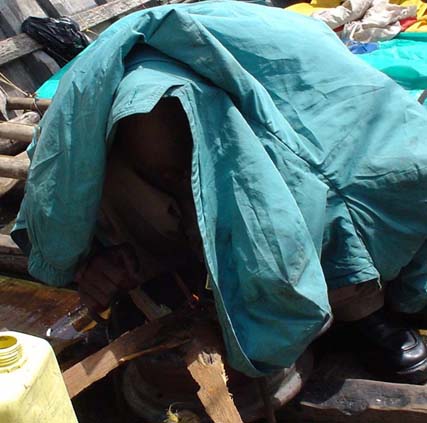
Photo: lighting the cooking fire at half wind Beaufort 3-4
Once it has started, of course, supply of oxygen is not one of the problems:
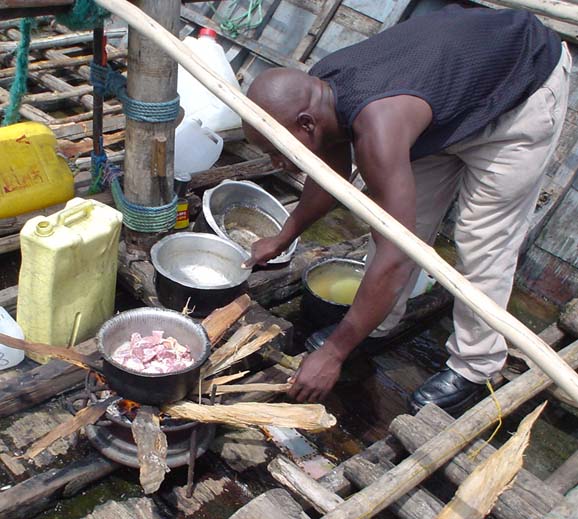
Photo: Boiling beef at half wind Beaufort 3-4
In an hour and a half we had crossed the entire Mwanza bay westward, and hit the shore. They wanted to take the opportunity to buy some fish here, which is much cheaper than in town.
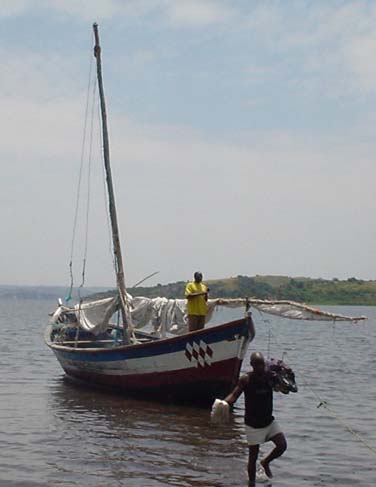
Photo: Hitting a shore to buy some fish (compare to Mwanza high bow model)
On return from the village, our meat was ready and the ugali was prepared.
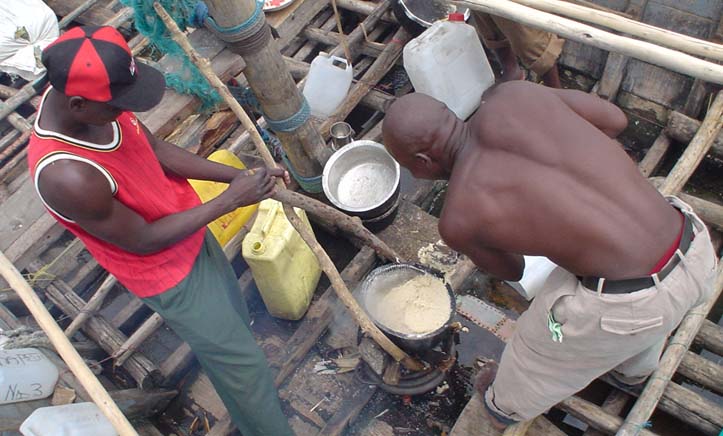
Photo: ugali (Italian: polenta, here a mix of maize and cassava powder) gets thick while boiling and resists stirring. One man stirs, the other fixes the hot pan with two branches.

Photo: lunch is ready. See the sail, rolled and bound
with banana tree leaves.
After hoisting the gaff (folmali), pulling the sheets causes the banana leaves
to break and the sail falls open.
From the sailors I retrieved a lot of useful knowledge on dhow building and sailing. At home I summarized it in Adobe Photoshop:
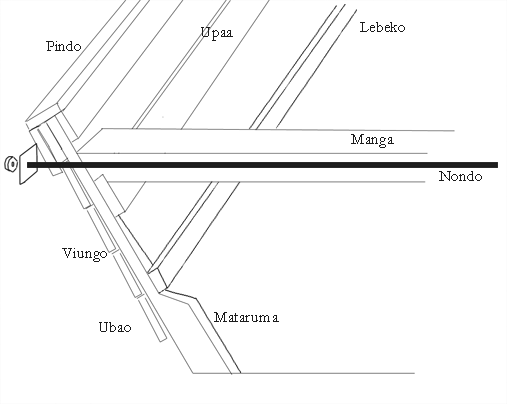
Picture above: construction terms
Picture above: sailing terms. For western sailers "chosi" (up an down tackle) and "kamlawi" (windward sheet) might be interesting, but the "balazi" is a genuine novelty: a gaff (folmali) sheet at the gaff's high side rear of the mast. You need only one "balazi" since all tacking goes by gybing (changing wind side down wind). While gybing, it is the main sheet that is walked around the mast, all four stays ("yali") and gaff ("folmali"), then given back to the stern. "Chalali" is halyard.
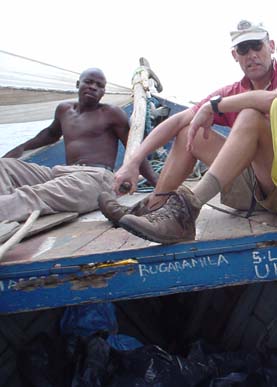
Photo: author requested to steer. His performance was approved,
he was invited to join the crew next time to their home village on Ukerewe,
a large Victoria Island one day of sailing North of Mwanza.
Since one likes this type of curve in the helm, one
searches the forest until one has,
of the right type of tree, the right model
and size of curved branch.
Goto: My First Trip With A Dhow; Dhow pictures
| Greetings Home |
| Previous Greeting |
|
|
| Previous Dhow Logbook |
| Next Dhow Logbook |